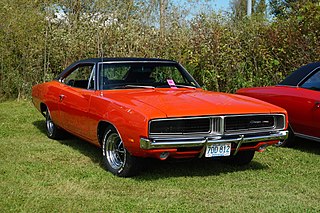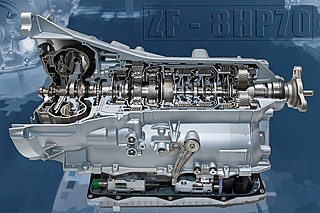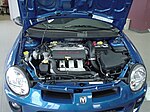
The Dodge Charger is a model of automobile marketed by Dodge in various forms over seven generations since 1966.

The Dodge Challenger is the name of three different generations of automobiles produced by American automobile manufacturer Dodge. However, the first use of the Challenger name by Dodge was in 1959 for marketing a "value version" of the full-sized Coronet Silver Challenger.

The Chrysler 300 is a full-size car manufactured and marketed by Stellantis North America and its predecessor companies as a four-door sedan and station wagon in its first generation and solely as a four-door sedan in its second and current generation.

The Dodge Durango is a mid-size/full-size SUV produced by Dodge in three generations starting with the 1998 model year. The first two generations were very similar in that both were based on the Dodge Dakota and Dodge Ram, both featured a body-on-frame construction and both were produced at the Newark Assembly Plant in Newark, Delaware through the 2009 model year.

The Jeep Grand Cherokee is a range of mid-size SUVs produced by the American manufacturer Jeep. At its introduction, while most SUVs were still manufactured with body-on-frame construction, the Grand Cherokee has used a unibody chassis from the start.

The Dodge Super Bee is a mid-sized muscle car marketed by Dodge, that was produced for the 1968 through 1971 model years.

The Chrysler Hemi engines, known by the trademark Hemi or HEMI, are a series of American V8 gasoline engines built by Chrysler with overhead valve hemispherical combustion chambers. Three different types of Hemi engines have been built by Chrysler for automobiles: the first from 1951 to 1958, the second from 1964 to 1971, and the third beginning in 2003. Although Chrysler is most identified with the use of "Hemi" as a marketing term, many other auto manufacturers have incorporated similar designs. The engine block and cylinder heads were cast and manufactured at Indianapolis Foundry.

The SJ series Jeep Cherokee is a full-size SUV that was produced from 1974 through 1983 by Jeep. It was based on the Wagoneer that was originally designed by Brooks Stevens in 1963.

The Dodge Charger is a full-size four-door sedan, first introduced at the 2005 North American International Auto Show and built by American automobile manufacturer Stellantis North America, a subsidiary of Stellantis. It is available in rear-wheel drive or all-wheel drive drivetrains. The Charger was developed to continue the Dodge Charger line with its muscle car heritage, and replaced the Dodge Intrepid as Dodge's full-size sedan. The seventh generation Charger debuted for the 2011 model year.

The Chrysler Pentastar engine family is a series of aluminium dual overhead cam 24-valve gasoline V6 engines introduced for the 2011 model year in Chrysler, Dodge, and Jeep vehicles. The engine was initially named "Phoenix," but the name was changed before the official launch due to a trademark conflict; the Pentastar name is derived from the trademark of the former Chrysler Corporation, which dates back to 1963.

R/T is the performance marker used on Dodge/Chrysler automobiles since the 1960s. R/T stands for Road/Track. R/T models usually come with R/T badging and a combination of upgraded suspension, tires, brakes, and often more powerful engines. Many models have also come with monotone paint and stripes as well as aggressive body kits. In 2004 the Chrysler SRT Division replaced R/T as the high performance auto group for Dodge vehicles, though the trim level is still in use on many current models with more powerful engines and cosmetic changes such as different rims and bumpers and grills and the R/T badge.

The Dodge Viper is a sports car that was manufactured by Dodge, a division of American car manufacturer FCA US LLC from 1992 until 2017, having taken a brief hiatus in 2007, and from 2010 to 2012. Production of the two-seat sports car began at New Mack Assembly Plant in 1991 and moved to Conner Avenue Assembly Plant in October 1995.

8HP is ZF Friedrichshafen AG's trademark name for its 8-speed automatic transmission models for longitudinal engine applications, designed and built by ZF's subsidiary in Saarbrücken, Germany. It had its debut in the BMW 7 Series (F01) 760Li saloon fitted with the V12 engine, and since then each new BMW model in all Series down to the 1 Series in rear-wheel-drive and all-wheel-drive versions have had the option to be equipped with it.

The Jeep Cherokee(KL) was a compact crossover SUV manufactured and marketed by the Jeep marque of Stellantis North America. Introduced for model year 2014 at the 2013 New York International Auto Show, sales began in November 2013. It occupied a position between the smaller Compass and the larger Grand Cherokee in Jeep's global lineup.

The third-generation Jeep Grand Cherokee (WK) is a mid-size SUV that was manufactured and marketed by Jeep from the 2005 model year through the 2010 model year. It was unveiled at the 2004 New York International Auto Show and subsequently in Europe at Euro Camp Jeep in Ardèche, France.

The Viper engine is a high-performance naturally-aspirated pushrod 2 valves-per-cylinder 90° V10 engine designed by Chrysler but with aluminum block castings designed by Lamborghini for use in the Dodge Viper. Despite its large displacement, it is based on the Chrysler LA V8.

The fourth-generation Jeep Grand Cherokee (WK2) is a mid-size crossover SUV produced by the American marque Jeep from mid-2010 to 2022. It was introduced in 2010 for the 2011 model year by Jeep. The unveiling took place at the 2009 New York Auto Show, where it was very well received and garnered 30 awards.

The Ram Rebel TRX is a 4x4 truck designed and produced by the FCA US LLC design studio for the 2016 Texas State Fair, introduced on September 29th of that year as an engineering, design and consumer-interest study. On June 1, 2018, Mike Manley, then head of Ram and Jeep, announced a production truck based on the TRX will be produced as a 2021 model year according to the five year plan. On August 17, 2020, the Ram TRX Launch Edition was unveiled for the 2021 model year.










































